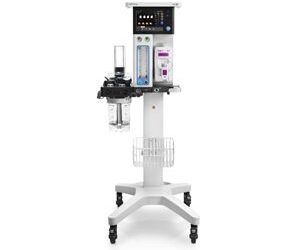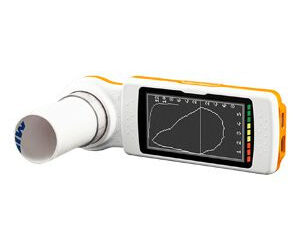What It Is, How It Works & the Best Options
Portable spirometers let clinicians measure lung function (e.g., FEV₁, FVC, FEV₁/FVC ratio, PEF) anywhere—at the bedside, in community clinics, or remotely through patient self-testing. With COPD, asthma, post‑COVID monitoring, and virtual care on the rise, these compact devices have become essential for fast, reliable pulmonary assessment and longitudinal disease management.
BOMImed is Canada’s top distributor of portable spirometers, offering a complete portfolio that spans entry‑level patient devices to advanced clinical-grade systems with Bluetooth, PC software, telehealth dashboards, and integrated oximetry.
What Is a Portable Spirometer?
A portable spirometer is a compact, handheld (or lightweight desktop) device that measures airflow and volumes during forced respiratory maneuvers. Most modern units:
- Report core indices: FEV₁, FVC, FEV₁/FVC, PEF, FEF25–75%, etc.
- Sync via Bluetooth or USB to smartphones, tablets, or PCs.
- Offer cloud connectivity, automated quality checks, and trend reporting.
- Use disposable mouthpieces/turbines to maintain hygiene and accuracy.
Why Clinicians Benefit from Portable Spirometers
Clinical impact
- Faster triage & decision-making at point of care.
- Remote monitoring of chronic respiratory patients (COPD, asthma, post‑COVID).
- Data-driven adherence tracking for inhaled therapies.
- Telehealth enablement with structured, standardized spirometry at home.
- Reduced lab bottlenecks—capture preliminary or follow-up metrics outside the PFT lab.
- Cost & workflow efficiency through simpler logistics and fewer in‑person visits for stable patients.
Operational advantages
- ATS/ERS-aligned accuracy in many portable units.
- Automated QC prompts (acceptability/repeatability).
- Easy integration with EMR/EHR or practice software (varies by model).
- Battery-powered mobility for outreach clinics, rehab, and occupational health.
How Portable Spirometers Work (In Brief)
Most portable devices use turbine, ultrasonic, or differential pressure sensors to calculate flow and volume:
- Patient performs forced exhalation/inhalation into the device.
- The sensor converts airflow/pressure changes into digital signals.
- Embedded algorithms calculate spirometric indices and compare to predicted normals.
- Results are displayed on-device or streamed to companion software/apps for storage, trending, and reporting.
What to Look For When Buying a Portable Spirometer
- Clinical accuracy & standards compliance (ATS/ERS).
- Connectivity: Bluetooth, USB, Wi‑Fi, APIs for EHR integration.
- Telehealth readiness: remote dashboards, patient apps, clinician portals.
- Integrated oximetry (SpO₂) for comprehensive respiratory assessments.
- Ease of use & patient coaching (onscreen prompts, traffic-light feedback, quality grading).
- Battery life & portability (truly handheld vs. lightweight desktop).
- Consumables & maintenance (single-use turbines, calibration needs).
- Reporting & analytics (trend charts, predicted values, GLI reference equations).
- Regulatory footprint & support in Canada—BOMImed provides national distribution, service, and training.
The BOMImed Portable Spirometer Lineup (Canada)
Fast Comparison Table
| Product | Best For | Key Highlights |
|---|---|---|
| Minispir Handheld Spirometer | Clinics needing PC-based spirometry | PC software workflow, comprehensive parameters, USB-powered |
| Smart One Spirometer | Patients & wellness monitoring | Ultra‑portable, app‑connected, simplified indices for self-monitoring |
| Spirobank II Basic Handheld Spirometer | Entry-level clinical use | Standalone display, essential parameters, no Bluetooth |
| Spirobank II Smart Spirometer | Connected clinics & telehealth | Bluetooth, app/PC integration, real‑time coaching |
| Spirobank Smart | Practices needing mobile, connected spirometry | Compact, Bluetooth-enabled, robust app ecosystem |
| Spirodoc Spirometer for PC | Advanced monitoring & research | PC software, detailed reporting, optional oximetry |
| Spirolab Spirometer with Oximetry | Full-featured clinic workstation | Integrated printer/display, oximetry, complete lung function suite |
| Spirotel | Home telemonitoring (COPD, asthma) | Telehealth-ready, daily trends, symptom & event tracking |
Product Snapshots
1) Minispir Handheld Spirometer
- Ideal for: Clinics that prefer PC-based workflows.
- Why it stands out: Delivers lab-grade parameters with robust software analysis and reporting.
2) Smart One Spirometer
- Ideal for: Home users and wellness programs needing simple, app-based monitoring.
- Why it stands out: Ultra‑portable, cost‑effective, patient-friendly UI—great for adherence and trend checks.
3) Spirobank II Basic Handheld Spirometer
- Ideal for: Clinics seeking a standalone device with essential spirometry metrics.
- Why it stands out: Clear on-device display, no reliance on smartphones or PCs for basic exams.
4) Spirobank II Smart Spirometer
- Ideal for: Telehealth-ready clinics and remote patient programs.
- Why it stands out: Bluetooth connectivity, advanced apps, quality grading, and versatile reporting.
5) Spirobank Smart
- Ideal for: Mobile clinicians who want Bluetooth + app functionality in a compact form factor.
- Why it stands out: Modern, connected, and optimized for quick deployment in multi-site settings.
6) Spirodoc Spirometer for PC
- Ideal for: Clinics that require PC-based diagnostics, trending, and optional oximetry.
- Why it stands out: Comprehensive reporting, robust analytics, and research-friendly outputs.
7) Spirolab Spirometer with Oximetry
- Ideal for: High-throughput clinics needing integrated SpO₂, printouts, and full desktop-level features.
- Why it stands out: All-in-one workstation—no external PC or printer required for standard workflows.
8) Spirotel
- Ideal for: Chronic respiratory disease remote monitoring (COPD, asthma, post‑COVID follow-up).
- Why it stands out: Telemonitoring-first design with daily trend tracking and clinician dashboards.
Implementation Tips for Clinics
- Define care pathways: Which patients qualify for home spirometry? Which metrics do you trend (FEV₁ drop %, PEF variability, symptom scores)?
- Standardize protocols: Ensure ATS/ERS acceptability and repeatability criteria are communicated to patients (or enforced via software prompts).
- Integrate with EHR: Choose devices and software that can export PDFs/HL7/FHIR or offer APIs.
- Train staff & patients: Short videos, printed instructions, and automated app prompts increase data quality.
- Track adherence & outcomes: Use dashboards to spot declines early (e.g., >100 mL FEV₁ drop) and intervene.
FAQs
1) Are portable spirometers as accurate as lab spirometers?
Many modern portable devices meet ATS/ERS standards for accuracy when used correctly. For diagnostic baselines, labs may still be preferred; however, for follow-ups, screening, and remote monitoring, portable units are highly reliable and clinically valuable.
2) What parameters should I monitor remotely?
Commonly: FEV₁, FVC, FEV₁/FVC, and PEF. Some programs also monitor symptoms, SpO₂, and event flags to contextualize lung function trends.
3) How often do portable spirometers need calibration?
It depends on the sensor technology (e.g., turbine vs ultrasonic) and the manufacturer’s recommendations. Many portable devices are factory-calibrated and require periodic verification with a calibration syringe in clinical settings.
4) Can these devices integrate with our EHR?
Several units offer PDF exports, USB/Bluetooth data transfer, or API/HL7/FHIR compatibility through companion software. Check your preferred model’s integration options.
5) Which device is best for telehealth?
Devices like Spirobank II Smart and Spirotel are built with Bluetooth, apps, and remote dashboards, making them ideal for virtual care programs.
6) Do I need oximetry in a portable spirometer?
If you manage COPD, interstitial lung disease, or rehab programs, integrated SpO₂ (e.g., Spirolab) can provide additional decision-making data without separate devices.
Resources (Products Mentioned)
- Minispir Handheld Spirometer — https://bomimed.ca/product/minispir-handheld-spirometer/
- Smart One Spirometer — https://bomimed.ca/product/smart-one-spirometer/
- Spirobank II Basic Handheld Spirometer — https://bomimed.ca/product/spirobank-ii-basic-handheld-spirometer/
- Spirobank II Smart Spirometer — https://bomimed.ca/product/spirobank-ii-smart-spirometer/
- Spirobank Smart — https://bomimed.ca/product/spirobank-smart/
- Spirodoc Spirometer for PC — https://bomimed.ca/product/spirodoc-spirometer-for-pc/
- Spirolab Spirometer with Oximetry — https://bomimed.ca/product/spirolab-spirometer-with-oximetry/
- Spirotel — https://bomimed.ca/product/spirotel/
Need help choosing the right spirometer?
BOMImed can help you select, deploy, and support the best portable spirometer for your clinic, hospital, or telehealth program—nationwide across Canada.













